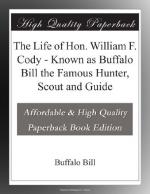The other Indians, upon learning what had happened to their “advance guard,” set up a terrible howling, and fired several volleys at us, but without doing any injury, as we were so well protected by the bank. We resumed our journey down the river, and traveled all night long. Just before daylight, Frank McCarthy crawled out over the bank and discovered that we were only five miles from Fort Kearney, which post we reached in safety in about two hours,—shortly after reveille—bringing the wounded man with us. It was indeed a relief to us all to feel that once more we were safe.
Frank McCarthy immediately reported to the commanding officer and informed him of all that had happened. The commandant at once ordered a company of cavalry and one of infantry to proceed to Plum Creek on a forced march—taking a howitzer with them—to endeavor to recapture the cattle from the Indians.
The firm of Russell, Majors & Waddell had a division agent at Kearney, and this agent mounted us on mules so that we could accompany the troops. On reaching the place where the Indians had surprised us, we found the bodies of the three men whom they had killed and scalped, and literally cut into pieces. We of course buried the remains. We caught but few of the cattle; the most of them having been driven off and stampeded with the buffaloes, there being numerous immense herds of the latter in that section of the country at that time. The Indian’s trail was discovered running south towards the Republican river, and the troops followed it to the head of Plum Creek, and there abandoned it, returning to Fort Kearney without having seen a single red-skin.
The company’s agent, seeing that there was no further use for us in that vicinity—as we had lost our cattle and mules—sent us back to Fort Leavenworth. The company, it is proper to state, did not have to stand the loss of the expedition, as the government held itself responsible for such depredations by the Indians.
On the day that I got into Leavenworth, sometime in July, I was interviewed for the first time in my life by a newspaper reporter, and the next morning I found my name in print as “the youngest Indian slayer on the plains.” I am candid enough to admit that I felt very much elated over this notoriety. Again and again I read with eager interest the long and sensational account of our adventure. My exploit was related in a very graphic manner, and for a long time afterwards I was considerable of a hero. The reporter who had thus set me up, as I then thought, on the highest pinnacle of fame, was John Hutchinson, and I felt very grateful to him. He now lives in Wichita, Kansas.
CHAPTER V.
IN BUSINESS.




